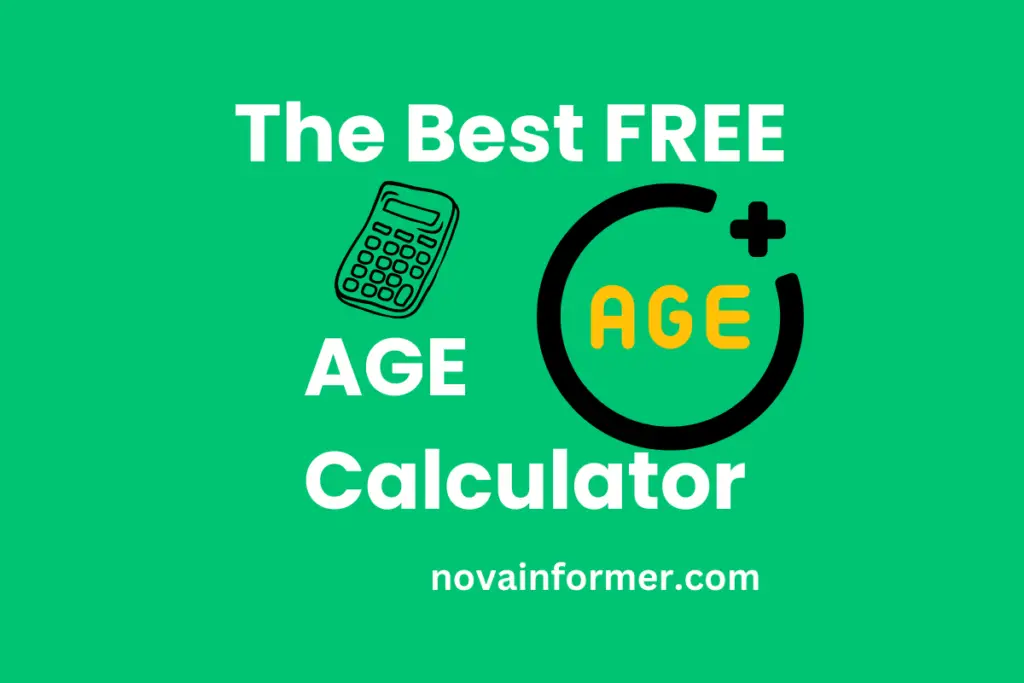Check how old you are today with our free age calculator. Simply enter your birthday date and see your age in real time.
**Don’t worry I will not share your input.
Ever wondered about the intricate dance of time in our lives? Age, the unassuming word that carries the weight of our existence.
In this journey, we’ll peel back the layers of age, exploring its biological, psychological, and societal dimensions. Get ready for a rollercoaster through the tapestry of life.
The Biological Aspect of Age
The Aging Process in Humans
Picture this: life as a grand adventure with distinct chapters. In infancy, it’s a whirlwind of growth; adolescence, a hormonal rollercoaster; adulthood, the pinnacle of vitality; and in the elderly phase, a graceful dance with declining physical functions.
Each age group has its own set of key characteristics, making the journey uniquely ours.
| Age Group | Key Characteristics |
|---|---|
| Infancy | Rapid physical development |
| Adolescence | Puberty triggers hormonal shifts |
| Adulthood | Peak physical and mental state |
| Elderly | Decline in physical functions |
Genetic Influence on Aging
Ever feel like your genes are playing puppeteer in this aging circus?
That’s because they are! Genetics acts as a roadmap, determining the speed bumps and smooth stretches on our journey through the ages.
Psychological Dimensions of Age
Cognitive Abilities Across Ages
Age isn’t just about the exterior; it’s a mental marathon too. In childhood, we soak up knowledge like sponges.
Adulthood is our cognitive peak, and in the elderly phase, some functions may take a back seat. It’s a cognitive symphony, each phase contributing to the masterpiece of our lives.
Addressing Age Stereotypes
Ah, age stereotypes – the unwanted guests at life’s party. But guess what? It’s time to show them the exit.
Embrace the uniqueness of each life stage. Life’s too short for societal scripts!
Societal Perceptions of Age
Cultural Variances in Defining Old Age
What’s considered “over the hill” in one place might be the prime of life in another. Let’s jet set through the globe to explore how cultures paint the canvas of aging.
Ageism: The Unwanted Guest
Ageism, the often-overlooked -ism. It’s time to shed light on age-related discrimination. Break free from the shackles of preconceived notions and foster understanding across generations.
How to Use this Age Calculator
Welcome to our Age Calculator – a simple tool to find out how many years, months, and days you’ve been on this planet.
Follow these steps to quickly calculate your age:
- Enter Your Birth Date:
- Click on the “Birth Date*” field to reveal a calendar.
- Select your birth date from the calendar.
- Calculate Your Age:
- Once your birth date is selected, click the “Calculate your age” button.
- Discover Your Age:
- Below the button, you’ll see a display that reveals your exact age.
- The age is presented in years, months, and days.
That’s it! You now know your precise age down to the day. Keep in mind that the tool considers a year as 365 days and a month as 30 days, so your birthday might not necessarily mean you’ll be 0 days old.
A Couple of Reminders:
- Your input is private – we won’t share it with anyone.
- If it’s your birthday, you’ll get a special “Happy B’day!!!” alert.
Feel free to use this Age Calculator whenever you’re curious about the journey you’ve taken around the sun. Enjoy exploring your age, and remember, age is just a number.
As we wrap up this part of our journey, remember – age is not a mere number; it’s the brushstroke that paints the masterpiece of our lives.
Curious for more insights? Join us in Part 2 as we delve into the challenges and opportunities age tosses our way. 🚀
Part 2
Key takeaways for this section
- Aging presents a spectrum of challenges and opportunities across health, career, relationships, and technology.
- Strategies for healthy aging encompass physical, mental, and emotional well-being.
- Career progression and transitions at different life stages require adaptability and strategic planning.
- Building meaningful connections in relationships involves adapting to evolving dynamics.
- Technology isn’t exclusive to any age group; it reshapes experiences and bridges generational divides.
Age and Health
Common Health Issues Across Ages
Children: Childhood illnesses and growth concerns often dominate this age group. Regular check-ups and vaccinations play a crucial role in maintaining health.
Adults: Chronic conditions become more prevalent in adulthood, influenced by lifestyle choices. Regular exercise, a balanced diet, and preventive care are essential.
Elderly: Degenerative diseases and mobility issues may arise. Maintaining physical activity, a healthy diet, and regular medical check-ups contribute to a better quality of life.
Strategies for Healthy Aging
Physical Well-being: Regular exercise, including both aerobic and strength training, supports physical health. A balanced diet rich in nutrients and adequate sleep are vital contributors.
Mental Well-being: Engaging in cognitive activities such as puzzles or learning new skills fosters mental acuity. Social engagement, connecting with friends and family, also plays a key role.
Emotional Well-being: Effective stress management techniques, coupled with nurturing relationships, contribute to emotional well-being. Maintaining a strong support system is crucial.
Age and Career
The Impact of Age on Career Progression
Navigating Stereotypes: Age-related biases can impact career progression. Emphasizing skills, staying updated with industry trends, and showcasing adaptability help overcome these biases.
Embracing Experience: Highlighting the value of experience and mentorship can turn age into an asset rather than a barrier. Showcasing a willingness to learn and adapt demonstrates professional growth.
Navigating Career Transitions at Different Life Stages
Early Career: Acquiring diverse skills and exploring different roles lay the foundation for a dynamic career. Networking and seeking mentorship contribute to early career success.
Mid-Career: Adaptability becomes key during mid-career transitions. Mentoring others while staying open to new opportunities fosters career longevity.
Late Career: Knowledge transfer and retirement planning ensure a smooth transition. Embracing a mentorship role and sharing insights contribute to a fulfilling late-career phase.
Age and Relationships
Dynamics of Relationships Across Age Groups
Friendships: Shared activities and mutual support form the backbone of lasting friendships. Flexibility and understanding contribute to the resilience of these connections.
Family: Open communication and understanding evolving roles within the family unit promote harmony. Balancing responsibilities with shared experiences strengthens family bonds.
Romantic Relationships: Quality time and adaptability to each other’s changing needs foster a thriving romantic connection. Communication remains the bedrock of a lasting partnership.
Building Meaningful Connections as One Ages
Friendship: Continuing shared activities and being supportive create enduring friendships.
Flexibility to adapt to changing circumstances maintains the vibrancy of these connections.
Family: Regular communication and acknowledging evolving family dynamics contribute to meaningful family relationships.
Understanding roles within the family unit enhances cohesion.
Romance: Quality time together and a willingness to adapt to changing needs keep romantic relationships vibrant. Effective communication is the linchpin of a successful partnership.
Technological Advances and Age
How Technology Reshapes Experiences
Tailored Experiences: Technology caters to diverse age groups, offering tailored experiences. From educational apps for children to health monitoring devices for the elderly, technology enriches lives.
Enhancing Connectivity: Technology facilitates connections across generations. Video calls, social media, and shared digital experiences bridge geographical and generational gaps.
Bridging the Digital Divide Among Generations
Seniors: Tech workshops and user-friendly devices cater to seniors, ensuring they can confidently navigate the digital landscape.
Youth: Mentorship programs and intergenerational projects create a bridge for the younger generation to share digital knowledge and experiences with seniors.
Part 2 has been a journey through the challenges and triumphs of aging. From health strategies to navigating career transitions and building enduring relationships, each life stage offers its unique set of opportunities.
As we anticipate the grand finale in Part 3, where we answer your burning questions about age, hold on to the excitement. 🎉
Gear up for the final stretch – frequently asked questions about age await you in Part 3. 🚀
PART 3
Key takeaways for this section
- Frequently asked questions demystify age-related concerns.
- Strategies to combat ageism include promoting awareness and challenging stereotypes.
- Adapting careers to different life stages involves a focus on skills, adaptability, and mentorship.
- Positive relationships across age groups thrive on communication, mutual respect, and adaptability.
- Technology barriers among older individuals can be overcome through user-friendly devices and support.
- Initiatives like intergenerational projects and mentorship bridge the digital generation gap.
Frequently Asked Questio
What are the common signs of aging?
Physical Signs:
- Wrinkles, grey hair, and changes in skin elasticity.
- Decreased muscle mass and bone density.
Cognitive Signs:
- Memory lapses and a subtle decline in processing speed.
How can one maintain physical and mental well-being as they age?
Physical Well-being:
- Regular exercise, including both cardiovascular and strength training.
- A balanced diet rich in nutrients and hydration.
Mental Well-being:
- Engage in cognitive activities, such as puzzles and learning new skills.
- Foster social connections to support mental health.
Are there effective strategies to combat age-related discrimination?
Promote Awareness:
- Advocate for awareness programs to combat ageism.
- Encourage workplaces to adopt inclusive policies.
Challenge Stereotypes:
- Share positive stories of individuals breaking age stereotypes.
- Promote intergenerational collaboration to showcase diverse strengths.
Can age affect job opportunities?
Navigating Biases:
- Emphasize skills and experiences on resumes.
- Stay updated with industry trends and continuously upskill.
How can individuals adapt their careers to different life stages?
Early Career:
- Focus on skill acquisition and exploration.
- Network and seek mentorship for guidance.
Mid-Career:
- Embrace adaptability and mentor others.
- Stay open to new opportunities and challenges.
Late Career:
- Facilitate knowledge transfer and plan for retirement.
- Embrace mentorship roles to share insights.
Are there industries where age is less of a factor?
Tech and Innovation:
- Many tech industries value experience and expertise.
- Start-ups often prioritize skills over age.
How can age differences impact relationships?
Friendships:
- Shared interests and activities bridge age gaps.
- Mutual respect for different life stages fosters understanding.
Romantic Relationships:
- Open communication about expectations and life goals is crucial.
- Adaptability to changing needs ensures relationship longevity.
What advice is there for fostering positive family dynamics across generations?
Communication:
- Regular, open communication about expectations and boundaries.
- Understand and respect evolving roles within the family unit.
What are the barriers to technology adoption among older individuals?
Lack of Familiarity:
- Provide user-friendly devices and conduct tech workshops.
- Foster a supportive environment for learning and exploration.
How can technology enhance the lives of the elderly?
Health Monitoring:
- Wearable devices for health tracking.
- Telehealth services for remote medical consultations.
Social Connectivity:
- Video calls and social media to stay connected with loved ones.
Are there initiatives aimed at closing the digital generation gap?
Intergenerational Projects:
- Programs that involve both young and older individuals in tech-related activities.
- Mentorship initiatives where tech-savvy youth guide seniors in digital literacy.
In Conclusion
Navigating the tapestry of age involves understanding and embracing its nuances.
From combating ageism to adapting careers, fostering relationships, and bridging the digital divide, this exploration leaves us with a richer understanding of the diverse experiences across generations.
Share your thoughts in the comments below, and let’s continue the conversation about the fascinating journey of age. 🌟
License:
by kamrul (https://codepen.io/kamrulpharmacist/pen/OJwKEMx)



